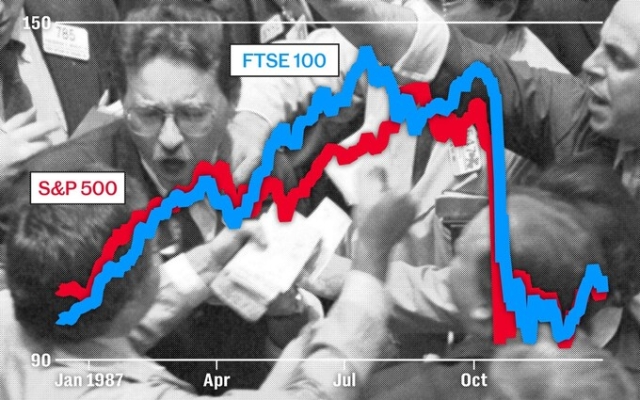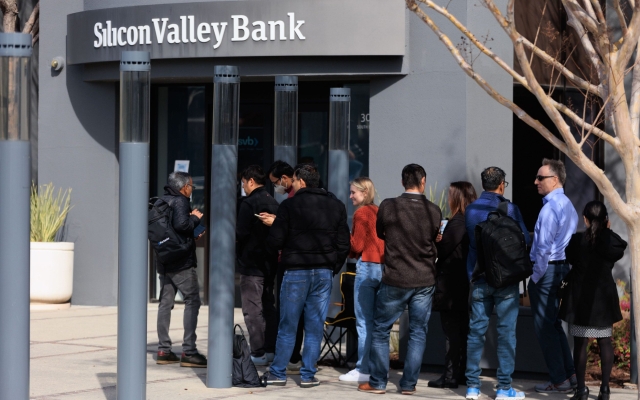
Even almost four decades later, this event remains a scar in the memory of financial markets. After a major storm swept across the country, downing trees and closing roads, trading systems that still relied on brokers shouting at each other across open floors closed early for the weekend as the damage was repaired.
As trading resumed in London on Monday after New York closed on Friday, the reaction was swift and brutal. The FTSE-100 index fell 11 percent in one session, and in the US the Dow Jones index ended the day down a terrifying 20 percent.
It became known as Black Monday, the worst trading day since the great stock market crash of 1929 and one that shaped policy for the rest of the decade.
As October 19, the 36th anniversary of Could the British and world markets expect a repeat of that fateful day? Many financial experts already see disturbing parallels between the two eras.
Bond markets are crashing around the world, just as they did in the lead-up to the 1987 crash. Debts are growing. Equity markets are overstretched and company values are in many cases on the brink of collapse. The seemingly unbreakable bull market is coming to an end. It's not hard to imagine how this could end with a devastating hurricane sweeping through the markets.
If this had happened, a market crash on the scale of 1987 would have been a catastrophic political and economic event. This will lead to sharp increases in interest rates, increasing costs for mortgage holders and for highly indebted companies, especially in the real estate sector. Businesses will fail and pension funds will be in trouble.
Perhaps most importantly, the already high cost of servicing the national debt will rise even higher. This will force profligate politicians to finally realize the consequences of their wild spending.
Over the past few weeks, many things in the financial markets are very similar to the situation in the late 1980s. However, there is an important difference. Politicians still had the financial capacity to respond to the Black Monday collapse. After two decades of easy money and constantly buffering markets with quantitative easing to prevent a crash, that no longer exists.
It remains to be seen whether we will see a repeat of 1987. One thing is certain. , however: if we do this, things will be much worse this time.
Bond Market Blitz
Investors are starting to worry about a repeat of Black Monday, primarily because of the sell-off in the bond market, where companies and governments issue debt and promise guaranteed returns. The bond market, usually a quiet corner of financial markets, has been caught in a wave of selling in recent weeks.
If you want a stark illustration of the bond market debacle, look no further than Vienna. At the height of the government debt bull market, Austria very wisely issued 100-year bonds and then reissued them in 2020. With a coupon of just 0.85%, investors would have to wait a century to get their money back. and with all this risk and patience they would have received a return of less than 1%.
Amazingly, in retrospect, the issue was 16 times oversubscribed as investors scrambled to give away their money for next to nothing until long after it was dead. And today? Bonds, perhaps unsurprisingly, fell in price. If you sell it, you will get back only 33 euros for every 100 invested.
Why anyone would want to lend the Austrian government money for 100 years is perhaps a question that only psychologists can answer. What is certain is that the bond market has fallen in value at an impressive rate over the past few months. Austrian 100-year bonds are an extreme example, but the value of most major bonds has fallen 40-50% over the past year, with losses accelerating over the past month.
Crisis is most often measured by yield — the yield offered by bonds, which moves inversely to price.
Yields have jumped to levels that even seasoned market professionals can barely remember. The yield on the 10-year U.S. Treasury bill, a key price driver around the world, closed at 4.9% on Friday, a level not seen since 2007. A year's worth of gold, which is significantly more than when Liz Truss supposedly crashed the economy a year ago.
The Italian government is paying around 5%, the highest level since 2011, when the eurozone was close to collapse. Germany, which had negative yields for most of the last decade, meaning investors were effectively charged a fee for lending to the government, now pays around 3%. In all major markets, the value of money is rising rapidly.
The bond market does not receive the same attention as stocks or real estate. Most of us are unaware that we own any bonds, just as we might own our home or a portfolio of stocks. But bonds are the critical backbone of the financial system, and many of them will likely be held by your pension fund, as will your bank, and your employer and, of course, the government will depend on the debt market for funding.
< p>B In total, the global bond market is valued at US$133 trillion (£109 trillion), or rather that's how it was last properly measured in 2022. When it collapses, it has a far greater impact on the day-to-day economy than any other part of the financial system.
High interest rates are not “temporary.”
There is no big mystery as to why prices fall and, as a result, yields rise. Investors are beginning to believe that interest rates will remain high longer than previously thought. As a result, they demand higher returns on their investments. The 100-year Austrian bond, which pays 0.85%, no longer reduces income.
The latest surge in government borrowing costs began with the US Federal Reserve's message in early September that interest rates should remain high for a long time.
Continuing strong employment figures in the world's largest economy are also a concern — a tight market labor stimulates inflation. Bond yields rose Friday after data showed the U.S. economy added nearly twice as many jobs as expected in August.
Investors and economists are also concerned about high levels of government borrowing. Both Italy and France have raised their deficit forecasts over the past month and show little willingness to bring borrowing back under control while President Biden's wild spending continues regardless of the impact it may have on the economy.
In the background, a huge surge in inflation following the Covid pandemic and the war in Ukraine has proved stubbornly resistant to raising interest rates. Central bankers, who just a few months ago smugly assured us that the rise in prices was only “temporary,” have begun to admit that inflation is as entrenched as it was in the 1970s and that rates will have to “stay higher.” » longer» to control it again.
We won't see rates below 1% for a long time. Result? Bonds have been massively repriced, even after five or ten years, in a world in which money is much more valuable than it has been for a generation.
Stock markets remain heavily overstretched
So far, we have yet to see a sell-off in the bond market has weighed on stocks, although higher borrowing costs will mean lower growth potential for companies. But this may well be only a matter of time.
In a note sent to clients late last week, Barclays argued that the only way to permanently stabilize the debt market rout is if stocks actually collapse as, well, amid a general revaluation of financial assets.
“We believe that the final path to bond stabilization lies through further revaluation of lower-risk assets,” bank analysts say. “We believe there is significant room for equities to decline until bonds stabilize.”
More pertinently, as the chart shows, the rise in bond yields is very similar to the rise in borrowing costs that led to the Black Monday crash of 1987. on exactly the same trajectory as the last six months. This only ended with a massive sell-off in October.
In 1987, stocks weren't even significantly overvalued compared to their long-term averages; Most share prices reflect realistic assumptions about earnings, growth and value.
With most indices now, with the exception of a few such as the UK's FTSE-100, stock markets are already heavily weighted with any historical comparisons — meaning that they will have to fall further if the crash does materialize.
Of course, there are many signs of stress in financial markets. The first tremors were felt here in the UK following the passage of the mini-budget last September. Markets were alarmed by the scale of the government's planned borrowing. The pound sterling collapsed and borrowing costs rose sharply.
Rising bond yields triggered the LDI crisis when pension funds became overzealous in instruments that assumed bond markets would remain stagnant for years. The sell-off began and the Bank of England was quickly forced to intervene to stop the situation spiraling out of control.
It was a stark illustration of how problems in the bond market can spread, but perhaps they will. will be relatively insignificant in the future.
There are many warning signs elsewhere, too. In the spring, there was a minor panic in the US caused by the collapse of a Silicon Valley bank, essentially caused by its overexposure to the falling bond market. Only the intervention of the Federal Reserve, much in the same way that the Bank of England had to intervene in the LDI debacle, prevented the phenomenon from spreading to other banks in the US, and several other regional financial institutions were forced to merge.
 Amid nervousness over losses Silicon Valley Bank suffered on its bonds, clients rushed to withdraw their money. Photo: Anadolu Agency
Amid nervousness over losses Silicon Valley Bank suffered on its bonds, clients rushed to withdraw their money. Photo: Anadolu Agency
Germany is facing a growing real estate crisis, with property values falling by almost 20% this year and developers starting to go bankrupt. In China, the debt-fueled property bubble is quickly running dry.
If a crash occurs, it would be easy for anyone to look back on all these events and conclude that the warning signs were all in plain sight.
Rising global mountain of debt
If the financial contagion does spread, the main victims will not be difficult to identify. In the UK we have already seen mortgage rates rise sharply and house prices fall somewhat modestly, but if there is a full-blown crash the situation will get much worse.
Other countries are doing just as badly. In the US, the average mortgage rate has reached 7.5%, the highest level since the beginning of the millennium. House prices in Germany are falling 7% a year, the sharpest fall in 23 years.
The collapse of the market will be felt by companies that borrowed cheaply and smugly believed that rates would never rise again, especially in private equity. The sector has bought up huge parts of the economy on the cheap and will have to start selling at huge losses once all that debt has to be refinanced at much higher rates.
Consulting firm Alvarez & In his report last week, Marsal estimated that $500 billion of corporate debt will have to be refinanced next year; All of these companies will have to pay much higher rates, which will put pressure on their businesses.
But it will be felt most painfully by governments for the simple reason that they have borrowed so much over the past decade.
In the UK, the cost of servicing our enormous mountain of debt has risen to £100 billion a year, double what it was a year ago and accounting for almost 11 per cent of total government spending. In France, debt costs are now the largest budget item, forcing Macron's free-spending government to save elsewhere. Interest on Italy's debts already eats up 4% of GDP every year, and that figure will only rise as Italy simply borrows more and more to stay where it is.
In the US, interest payments on the national debt are projected to rise from $475 billion last year to $1.2 trillion by the end of the decade: all of President Biden's green technology investments will have to generate huge profits to make all that borrowing look worthwhile.
In fact, all major governments in developed countries will have to start cutting their spending and cutting back on borrowing just to get their spending under control. When you add it all up, adjusting to higher rates will be very difficult.
What would happen if there was a financial crash as spectacular as the Black Monday crash in 1987?
“There was no major recession in the UK at the time, for example, until the early 1990s,” says Neil Shearing is chief economist at Capital Economics. “This time the UK economy is adjusting to a prolonged period of rate hikes, which means the economy is already struggling. There will be no buffer for the shock.”
Western economies are losing their shine
There are some big differences between 1987 and 2023. Overall debt levels were then much lower and government debts were much less burdensome. In the US the debt to GDP ratio was then only 48% compared to 120% now, and in the UK it was also well below 50% compared to 100% now. Interest rates were significantly higher, and households and companies had significantly less debt, giving them much more flexibility to cope with the collapse.
Perhaps more importantly, governments have already begun the hard work of making their economies more competitive. The crash of 1987 occurred in the middle of the Reagan-Thatcher project to reset Western economies, limit the overwhelming power of labor unions, privatize inefficient government monopolies, and return power to companies and entrepreneurs.
All of this has just begun to pay dividends, unleashing a wave of innovation and growth that has allowed the economy to grow even during periods of financial turbulence. That doesn't mean it didn't matter. The loosening of fiscal policy after the Black Monday crash led to a spiral of inflation that may have led to the fall of the Thatcher administration in 1990 and the defeat of Reagan's successor George H. W. Bush in 1992. a time when the largest developed economies became stronger.
Today this is certainly not the case. In fact, all Western economies have been gradually weakening over the past fifteen years. Government spending has grown exponentially, much of it covered by printed money. Regulation has been endlessly increased. Governments have been captured by lobby groups and corporations have been dominated by ideologically driven managers committed to social values rather than innovation and economic growth.
The corporate raiders who disciplined bloated management hierarchies in the 1980s are a thing of the past. The crash of the 1980s, in retrospect, turned out to be little more than a punctuation mark, rather than the closing of one chapter and the beginning of another.
The same cannot be said for the crash of 2023, if it happens. This may well mark the moment when two decades of relentless government expansion, increased welfare benefits, and skyrocketing debt financed by cheap money begin to unravel. Governments, corporations and households will have to start living within their means again, and growth will only be possible through innovation and productivity, not printed money.
When we look back to the 2030s or 2040s , this could very well be considered a good thing. The collapse will force us to focus on restoring real growth. But until then there will be a lot of pain. We've already seen this in the bond markets over the past few weeks — and we could see it everywhere very soon.





















































Свежие комментарии